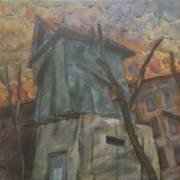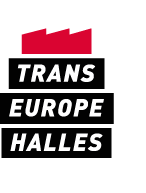Haunting Cubed
Exposition du vendredi 01 septembre 2023 au dimanche 01 octobre 2023
vernissage le : samedi 02 septembre 2023 à 17:00
VICTOR CIOBANU
exposition du 1er septembre au 1er octobre 2023
!!! vernissage -reporté à samedi 2 septembre dès 17h!!!
Haunting Cubed
There is a certain patina of color in Victor Ciobanu’s paintings that is quite troublesome. I would dare say,
uncanny. The same could be said about his kinked pencil strokes. There is also a certain forgery and
deception about them and about the way he presents his objects or shall one say subjects? For a few years
now, Ciobanu records on paper still functional buildings erected in Soviet Moldova. At a time when the
human body was actually projected into the buildings and was the core of the architectural projects. Mr.
Ciobanu is preserving in a way, but also processing memories or nostalgias like many other artists in
Eastern Europe do. He is also rehandmaking them, replacing them into a nonlinear pure space. Ciobanu’s
works are haunted in a multitude of ways. This comes in layers and with different persistent intensities.
Firstly, despite their cracked and crumbling state, and the time that is eating at them, there are, the socialist
realist apartment blocks, objects that imply homes. There are also places of culture exchange, like former
cinemas, that imply gatherings of individuals that shared a collective experience. Mr. Ciobanu presents an
unsettled heritage and the unquestionable material values of this architecture, both central, but also grassroots,
architectural patchworks, supposedly temporary dwellings.
Then, unusual elements appear in his frames – cables, cars, welded metallic children playground
installations, pigeon houses. These new layers find themselves at peace in Ciobanu’s compositions, even
though they seem incompatible in the reality he is collecting them from.
Then came the unexpected war. As Russia invaded Ukraine, buildings similar to the ones in Mr. Ciobanu’s
drawings were collapsing under Russian bombardments, burying their inhabitants under them. The
buildings, that were once the pillars of safety, had also in them the potential to become graves. Moldovans
were forced to imagine that they would be invaded next and also buried under concrete of their apartment
buildings.
The Russian war in Ukraine affects Moldova in a straightforward and dialectical way. No fly zone was
declared over Moldova in the beginning of the war, the inflation jumped up, refugees were coming in,
sometimes just crossing through the country. The electricity would get cut once in a while, reminding
Moldovans about similar cuts after the collapse of the USSR and their ongoing energetic dependence on
Russia. Moldovan activists, influencers and other public figures would cheer up their fellow citizens by
posting messages on no lights but also #безвас – no you, spelled out, however in Russian, and cyrillic
letters. But besides the activists and the online noise, the evenings were quiet and stiff. A cold loneliness
would engulf Chisinau – Moldova’s capital city – as Mr. Ciobanu describes.
The scope of home constitutes an overlapping series – the family, friends, a place to live, a house, the
neighborhood, the city, the nation, as Anthony Vidler puts it in his “Architectural Uncanny: Essays in the
Modern Unhomely”. Moldova, Ukraine and Russia constituted once, not so long ago, one nation. People
from these ethnicities would often intermarry and change habitats to various USSR republics, and not
necessarily on a forced basis. For this to happen the traditional inter ethnic hatred needed to be
suppressed. Now the hate is back, it turned things out of place, and it haunts us in our homes. Russians,
once husbands, wifes, fathers and mothers, partners and friends, kill and shell Ukrainian homes, also of
Moldovans and Ukrainian Russians or Ukrainians of Moldovan or Russian descent who live/d in the
bombarded areas of Ukraine. Rockets fly regularly over Moldova too. Sometimes they even fall on
Moldovan territory. Ukraine retaliated. In both, Ciobanu’s and Vidler’s words, the cities become strange,
and distance themselves from reality, forced by reality – once safe and cheerful, now dangerous and
attracting hatred and shelling. In the eyes of the civilians, it seemed the cities turned against their subjects.
Mr. Ciobanu finds it difficult, but nevertheless, he keeps attempting to sketch the change that takes place in
the urban landscape of Chișinău after the beginning of this war. Among the ways of putting it was to
pigeonise the apartment blocks, as they were deprived of warm light, in other words, of electricity. In the
courtyards of some of the Chisinau’s blocks, and perhaps Kiev’s blocks, or Bucha’s, to this day one might
find pigeon houses. These miniature handmade cubic installations grew out of the appartment blocks as a
result of a law of life, perfect to be transported one day in the white cube of a gallery. Nobody ever tried to
stretch electricity into them. Nor pigeons, nor doves, that used to live in these quarters, needed electricity.
Considered the symbol and guarantors of peace, these white birds contained the immaculate bright light
within their bodies. As they moved into their new flats, the new inhabitants of the blocks brought with them
the passion for pigeons as well as the eagerness to set aside differences and share a common space with
the new neighbors – the blocks’ courtyards.
The doves were everywhere once: on banners and placards, on book covers, on postcards, on mosaics, in
poems. Today many of these dove houses are empty. The locals who took care of them, either got too old,
passed away, migrated, lost interest in caring for peace or simply ate them in the austerity bound period of
transition. The pigeon houses are currently also haunted.
As the war entered our apartments and houses, some of us discovered in ourselves the return of the urge
for solidarity. Refugees from Ukraine, no matter their ethnicity, sometimes broken or fragmented, were
hosted in the empty apartments of the old Soviet blocks. So far these blocks can still offer shelter. And
even though the electricity gets cut once in a while, it comes back, and no bombs have fallen on them yet.
And when the light is turned on, it is golden and warm, like it used to be, when people were able to set
aside the nuisance related to their otherness, and not being afraid to embrace it.
To account for the unusual golden color depicted in the photographers at the decline of the Polish People’s
Republic art historian and anthropologist Olga Drenda talks about pollution, about special chemicals that
were specific to famous Orvo photofilms used in the late 80s, but also, she says, photographers mentioned
a very special and site specific color in the Polish air. Interestingly, she doesn’t mention the golden hours –
the period of the day in which the sun hits under a specific angle in such a way that almost everything
shines, no matter how dark and depressing the surrounding environment might be. Mr. Ciobanu manages
somehow to bring this golden patina in his works, no matter how uncanny is the topic that he is trying to
account for. The golden patina in his works is quite real. One can experience it to this day in Chișinău.
Paradoxically, Mr. Ciobanu’s works with shaky blocks and pigeon houses on the walls of our dwellings can
make our interiors more livable, closer to a desired perfection. Mr. Ciobanu’s cubic subjects will bleed,
exhaust, whirl, and break, to use Coop Himmelblaus’ words, and therefore safely contain in its frames
much of the uncanny that could appear in the intimacy of our living quarters, making them homier, and
keeping them and us safe. They will bleed gold, becoming icon-like images of unease. Mr. Ciobanu’s works
are antimodernist charms that one should not miss.
Teodor Ajder





Trackbacks (rétroliens) & Pingbacks
[…] Versiunea engleză a textului poate fi citită aici. […]
Les commentaires sont désactivés.